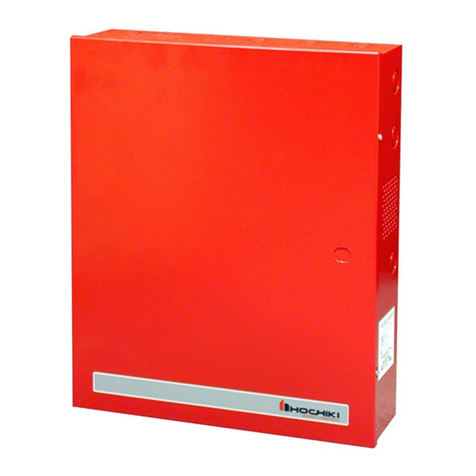
Hochiki Europe (UK) Ltd – HE-PSU(1.25) Power Supply Installation Manual
Page 3 of 4 2-3-0-995/ISS1/OCT07
Suitable cables should be brought into the cabinet using the knockouts provided, making sure that tails are
long enough to reach the relevant terminals. The screen or drain wire should be bonded to earth at one
location only, it should be continuous throughout the circuit. Terminals will accept one single or
stranded conductor up to 2.5 mm2.
2.0 COMMISSIONING
2.1 Mains Connection
The mains is connected to the PSU via a fused terminal block marked with live, neutral and earth
symbols. It is imperative that the equipment is soundly earthed and this connection should be made
and checked first.
Following connection of the live and neutral cables and with no other connections made, the unit should be
powered and the battery output measured at around 28 volts DC.
2.2 Load Connection
Terminals are provided for connection to the load and are marked + and -. The voltage at these
terminals under normal conditions (i.e. off load) should be around 28.5 to 29 volts. With the mains
power off, connect the load cables.
Double check the load connection for correct polarity before switching on mains. After switching on
mains check the voltage at the load for correct polarity.
Do not connect or disconnect the wiring to the load terminals with mains or battery power on.
2.3 Fault/Healthy Connection
Switched -VE outputs are available for signalling of power fault and power healthy indication marked PO
(power on) and PF (power fault). Under normal circumstances (mains and battery connected and fuses
intact) the -VE appears at the PO terminal.
Failure of the mains or battery supply will transfer the -VE to the PF terminal.
A volt free changeover contact is also available for fault/healthy signalling which can be used to switch
other voltages or signals
2.4 Battery Connection
An output is provided via flying leads with 0.25 inch spade receptacles for connection to sealed lead acid
rechargeable batteries. Normally two 12 volt batteries are connected in series and then to the charger.
Before connecting the batteries measure the output voltage on the leads. It should be 28 volts ±0.1
volt. If the voltage differs from this, adjust it to the correct level using the control on the PCB (this may
vary from the factory setting due to variations in mains supply voltage).
It is very important that the correct polarity is observed before connecting the batteries as the wrong
polarity connection will blow the charging fuse and may damage the unit.
With the batteries connected and the mains on the fault contact should show continuity between the “C”
and “NC” terminals. With the battery on mains disconnected the fault contact should show continuity
between the “C” and “NO” terminals.
With the battery connected switch off the mains and ensure that a supply is present at the load terminals.
3.0 OPERATION & MAINTENANCE
Under normal circumstances the power supply requires no attention and will transfer automatically to
battery supply in the event of a mains failure. Periodic checks should be made however to ensure
maximum life of the sealed lead acid battery.
To do this, disconnect the battery and using a calibrated voltmeter ensure that the voltage on the
battery leads is 28 volts ±0.1 volt. Adjust this if necessary using the control on the PCB.
























